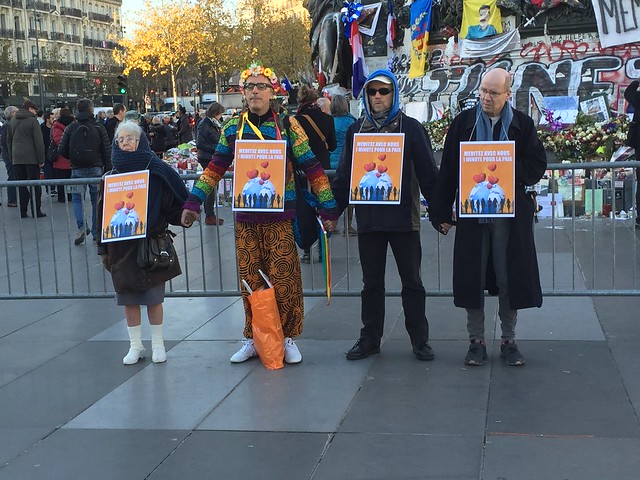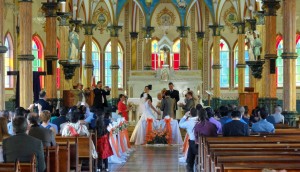This morning was yet another headache, but gradually they were getting better, so hopefully they will go away completely soon. Part of the problem is that I never got over the long and difficult plane ride here, especially the overnight flight when I couldn’t easily get up to walk around due to a large sleeping person in the aisle seat. If I were traveling in the United States, I would look for a YMCA to swim at — I’m a member in Columbus, and you can swim at Ys all over the country. But I tried googling it in Paris, and the only two facilities seemed to be shelters for homeless men, not workout facilities. So I tried asking the hostel staff at the front desk. They recommended a pool that had lap swimming hours all the way until midnight. That was a new one on me – I’ve never heard of a pool staying open past 10 p.m. But I got the information and figured I’d give it a try.
Today saw two major events and some good news. One, the Climate Summit for Local Leaders, was only open to mayors, city leaders, and their staff, so I could not go. But this meeting would bring some excellent news: After a rousing speech by Leonardo DiCaprio in he told them “Do not wait another day” to move to renewable energy, 1000 mayors from around the world signed a pledge to take their cities to 100 percent renewable by 2050. This is hugely important because cities are responsible for an estimated 75 percent of global carbon emissions, with transport and buildings being among the largest contributors. Climate action truly starts on the local level.
Another piece of good news also broke: Germany and France became the first developed nations to join the new Climate Vulnerable Forum, a group of mostly island and African nations highly vulnerable to climate change, in calling on COP 21 to lower the target for warming from 2 degrees C to 1.5 degrees C. (Canada, the United States, China, and the European Union would later join them.) Half a degree does not sound like much, but on a global scale it is a lot. It is the difference between whether the Greenland and Antarctic ice sheets completely melt, and whether island nations such as the Marshall Islands continue to exist.
The other major event today was the International Rights of Nature Tribunal, a two-day simulated court hearing that explored the rights of nature as a legal concept and how they might be defended in a series of cases in which various violators of those rights were prosecuted. The first day was today, but the event was one in a series of events in the history of the movement for the rights of nature. The movement was first galvanized in 1972 with the publication of Should Trees Have Standing? by Christopher Stone, which I learned about this semester in my environmental law class.
For a long time the concept was discussed only in academic circles, but in 2008 Ecuador adopted a new constitution that granted rights to nature. According to Article 71, “Nature or Pachamama, where life is reproduced and exists, has the right to exist, persist, maintain and regenerate its vital cycles, structure, functions and evolutionary processes.” Then, in the wake of the failed Copenhagen climate conference of 2009, President Evo Morales of Bolivia hosted the People’s Conference on Climate Change and the Rights of Mother Earth, which crafted and endorsed the Universal Declaration of the Rights of Mother Earth. Designed to complement the Universal Declaration of Human Rights, this declaration was meant to drive home the point that without a habitable environment including clean air, water, and land, human rights cannot exist.
 The two-day proceeding this year featured several themes, explained by Cormac Cullinan, author of Wild Law: A Manifesto for Earth Justice and Osprey Orielle Lake, founder of Women’s Earth and Climate Action Network. First, in current legal frameworks across the world, everything other than humans and corporations is considered property, including all rivers, trees, mountains, and animals, Cullinan said. When something is property, it has no voice, and cannot defend itself; it will necessarily be exploited. Current law is based not on the concept that humans are part of nature, but that we can dominate and exploit nature with no consideration for other members of the earth community. However, with climate change and a host of other environmental disasters looming, it has become clear that in operating under this paradigm, we are destroying our own habitat. To address this, Cullinan argues, we must shift away from an anthropocentric point of view to seeing our role not as dominators but caretakers of the earth.
The two-day proceeding this year featured several themes, explained by Cormac Cullinan, author of Wild Law: A Manifesto for Earth Justice and Osprey Orielle Lake, founder of Women’s Earth and Climate Action Network. First, in current legal frameworks across the world, everything other than humans and corporations is considered property, including all rivers, trees, mountains, and animals, Cullinan said. When something is property, it has no voice, and cannot defend itself; it will necessarily be exploited. Current law is based not on the concept that humans are part of nature, but that we can dominate and exploit nature with no consideration for other members of the earth community. However, with climate change and a host of other environmental disasters looming, it has become clear that in operating under this paradigm, we are destroying our own habitat. To address this, Cullinan argues, we must shift away from an anthropocentric point of view to seeing our role not as dominators but caretakers of the earth.
To do this, Lake argued, Western cultures should look to how indigenous peoples live in harmony with nature. Currently 80 percent of biodiversity on earth is in the care of indigenous peoples, and we should understand how they maintain it. We must stop the financialization and commodification of nature and reconnect with the earth as a solution to the current climate and environmental crisis. Lake also condemned market mechanisms such as cap and trade for carbon emissions and the United Nation’s Reducing Emissions from Deforestation and Forest Degradation (REDD) program as simply giving out permits to pollute, which causes the problem in the first place.
The tribunal consisted of eight presentations before a panel of judges:
- Climate crimes against nature, including fossil fuels, deforestation, water and climate, market mechanisms, climate smart agriculture, land use, carbon capture and storage, free trade agreements, geoengineering and nuclear energy.
- Financialization of nature, including compensation mechanisms linked to biodiversity conservation, EU biodiversity offsets, REDD+, and economic valuation of nature in general.
- Agro-food industry and GMOs
- Defenders of Mother Earth, referring to the criminalization of environmental activism and the sharp increase in murders of environmental activists, especially in the Global South.
- Shale fracking operations, which speakers argued was akin to rape of the earth, resulting in earthquakes and entailing man camps that raised crime and violence.
- Megadams in Brazil, which destroy ecosystems and displace tens of thousands of indigenous people.
- Recognizing ecocide as a crime at the International Criminal Court through two cases: oil exploration and removal in Ecuador’s Yasuni National Park, and oil spills and toxic and hazardous waste left behind by Texaco/Chevron.
You can find an agenda for the tribunal here, a press release describing it here, a full overview and report here, and news coverage from the Guardian, National Catholic Reporter, and Indigenous Rising. You can also see the tribunal’s press conference in the Blue Zone here.
That evening at Place to B, many of the presenters, witnesses, and judges from the tribunal appeared at the two-hour Place to Brief. In the video above, most of the French and Spanish speakers were not translated, but you can hear speakers in English including Natalia Greene, who was instrumental in getting the new constitution passed in Ecuador; Cormac Cullinan, who gave an overview of the tribunal; Shannon Biggs, founder of Movement Rights who led the panel on norms; Osprey Orielle Lake, who talked about the rights of nature; and Roger Cox, lead attorney for a citizens group that won a landmark ruling ordering the Dutch government to lower carbon emissions 25 percent in five years to protect its citizens. Vandana Shiva gave closing remarks in a separate video. I did not attend this, so I am very happy that Place to B posted the recording.
I spent the late afternoon and early evening visiting memorials for the victims of the Paris terrorist attacks three weeks ago. The memorials are still quite fresh. I got more detailed photos at Place de la Republique, then went to the Bataclan club where the worst occurred and took a number of photos there. The club is still closed, but the entire sidewalk in front and to the side is filled with flowers, messages, candles, and the like. Across the street up and down for several blocks are more memorials. I took a ton of photos in an attempt to capture the scale of the items left, as well as what some items, especially those paying tribute to specific victims, looked like. My Paris Memorials album is posted on Flickr. Page through at whatever pace you like, but you might want to have some some tissues handy.
After that I found some dinner with the idea of getting in a a late swim at Piscine Pontoise, the pool the staff at the hostel had told me about. Dinner in France is never a hurried affair, and it was after 9 p.m. before I got done and after 10 p.m. before I made it to the pool. The journey was worth it. The pool was about half-again as long as the standard 25-meter pool used for lap swimming in the United States, so even with three people in the lane I could still get in a good workout. But best was the ambience. The whole place was flooded with low blue lights and jazzy music. You had to take your shoes off to get to the dressing rooms, but you got your own room that was kept locked by the attendant. I managed to get in a mile, which was sorely needed and helped change my outlook for the upcoming week.







